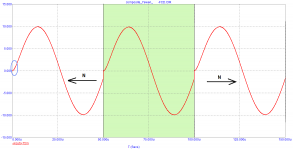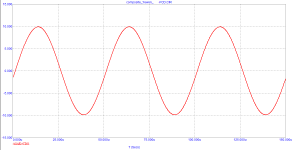There is no such thing as measurement made virtually. It may take 48 years and billions of dollars but existence of Higgs boson is confirmed. Unmeasured stuff is simply an opinion. We have plenty of standardized measured parameters describing quality of an amplifier. It is not funny that you want people to accept unconfirmed (virtual) distortion as fact.
There is no such thing as measurement made virtually. It may take 48 years and billions of dollars but existence of Higgs boson is confirmed. Unmeasured stuff is simply an opinion. We have plenty of standardized measured parameters describing quality of an amplifier. It is not funny that you want people to accept unconfirmed (virtual) distortion as fact.
Sarcasm? 😱
one feels that a person is far from progress, he simply does not know that today everything is designed and tested in advance virtually.sarcasm?
Most of us know that there is little reason to blindly trust unconfirmed simulation results. Would you accept result of simulated listening test?
Last edited:
You can confirm that with an oscilloscope and show both input and output waveforms.
Last edited:
It is often discussed what the minimum slew rate of the output voltage is acceptable in the op amp. I have repeatedly met information that SR> 50V / us is needed so that its influence does not affect the sound quality.
Here is one of John Curl's comments on NE5534
John Curl's Blowtorch preamplifier part II
this microcircuit has SR = 13 V / us. If we assume that the amplitude of the output voltage is 13 V (peak), then the normalized slew rate is NSR = SR / 13 = 1 1 / us
Slew rate of 50 V / us will correspond to full power bandwidth (FPBW)
FPBW = SR/(2*pi*Vp) = 50/6,28*13 = 0,6 MHz
This value is one and a half times lower than what Mike Malinowksi considers optimal
Audio Reference Co.
I think it will be useful to read this article too.
https://pdfs.semanticscholar.org/df...44.1779036581.1609507247-773396060.1609507247
Here is one of John Curl's comments on NE5534
John Curl's Blowtorch preamplifier part II
this microcircuit has SR = 13 V / us. If we assume that the amplitude of the output voltage is 13 V (peak), then the normalized slew rate is NSR = SR / 13 = 1 1 / us
Slew rate of 50 V / us will correspond to full power bandwidth (FPBW)
FPBW = SR/(2*pi*Vp) = 50/6,28*13 = 0,6 MHz
This value is one and a half times lower than what Mike Malinowksi considers optimal
Audio Reference Co.
I think it will be useful to read this article too.
https://pdfs.semanticscholar.org/df...44.1779036581.1609507247-773396060.1609507247
Avoid use of opamps in your amplifier, end of story.It is often discussed what the minimum slew rate of the output voltage is acceptable in the op amp...
And in the same way, it can be predicted based on the amplitude and phase characteristics. Why do we need to enter additional parameters and terms? Since the group delay time is a derivative of the phase in frequency, they correspond to each other for minimum-phase systems, which we take amplifiers to be. This may be a secret knowledge for you, but the wider the frequency band, the smaller the group delay time. Just look at the amplitude characteristic and think. Think about whether you can organize a unity gain bandwidth under 10 MHz on a real board and ensure the stability and stability of the parameters.If yes-go ahead, no-then you need to reduce your appetite and make compensation differently. And in the simulator, everything looks good until the time comes to implement it in hardware.I use the test in the first period only as an express analysis, nothing more.
If you've read my amplifier testing reviews, they include over ten different tests. Not every review has all of them, of course.
strictly speaking, having some experience, you can predict the behavior of the amplifier by looking at the group delay
If you still mask the step signal when exposed to a sinus burst, then why don't you use a rectangular signal at once, as I have said repeatedly? In addition, it is logical to use the "transient analisys" mode to view the transient process, and not to convince everyone that it is just a sine wave and the amplifier is not able to cope with it.measurements are made virtually, and Graham has repeatedly written about this. If we are interested in what is happening in the first period, then we can see it visually using the transient analysis. I am delighted with the book by Jiri Dostal where he described in detail the distortions arising in the amplifiers.
all measuring devices contain filters whose settling time is rather long. Therefore, their readings are averaged, like the average temperature of patients in the hospital: 39 degrees in patients, and 33 degrees in a morgue, an average of 36 degrees (conditionally)
Measuring instruments do everything right, because their task is to measure non-linear distortions, not linear ones. And when you understand this, you will stop hammering nails with a microscope.
No, it's you who make him see as if your amplifier is not working, but constantly turns on as Damir said. Is that how the amplifier works at home? In addition, using a standard macro from the library to compensate for the delay, you yourself produce distortions, since it is not intended for this purpose.for the simulator, the first period looks like this
fаgos: “No, it's you who make him see as if your amplifier is not working, but constantly turns on as Damir said. Is that how the amplifier works at home? In addition, using a standard macro from the library to compensate for the delay, you yourself produce distortions, since it is not intended for this purpose.»
how did you get with your conjectures!
In your opinion, what is highlighted in yellow I created myself
how did you get with your conjectures!
In your opinion, what is highlighted in yellow I created myself
Attachments
Do you still not understand that there is a transition process when you turn on the scheme? The simulator shows you the same thing in essence, and you try to connect it with the sound quality. Yes, different amplifiers are used in different ways depending on their modes and frequency characteristics. Is this news to you? How does this relate to sound quality?how did you get with your conjectures!
In your opinion, what is highlighted in yellow I created myself
Last edited:
He would not understand before he makes real measurement. He has no idea how real amplifier operates.
Since the group delay time is a derivative of the phase in frequency, they correspond to each other for minimum-phase systems, which we take amplifiers to be.
Amen to that.
a) Audio amplifiers are minimum phase systems, therefore:
b) The phase (for all cases, closed loop gain, open loop gain, loop gain, etc...) is not independent but uniquely determined by gain magnitude vs. frequency, through a simple Hilbert transform.
c) Group delay is by definition minus the derivative of the phase with respect to frequency, therefore, using the transitivity property in formal logic for a), b) and c) we get the conclusion:
The group delay is uniquely determined by the gain-frequency characteristic of the audio amplifier. Please note, no assumptions were made above about the amplifier structure or topology (can be with or without NFB, can be a VFA or CFA, etc...).
The only exception to the above it that the minimum phase assumption may break when the frequency approaches the active devices unity gain frequencies (like Ft for bipolar devices). These residual poles can be (and usually are) placed in the RHP, therefore the system is no longer of minimum phase. But then that's precisely why we compensate amplifiers, to isolate these residual poles and make them irrelevant. But this is a strictly theoretical scenario, since I can't imagine a sane designer using bipolars with Ft=200MHz and designing his audio amplifier with 150-200MHz bandwidth.
I understand the above are not easy to digest for somebody like out dear petr_2009, but these are facts known to EEs for decades. Debating these facts can only be either the result of a lack of basic EE knowledge (combined with the Dunning Kruger effect), a trolling exercise, or both.
I understand the above are not easy to digest for somebody like out dear petr_2009, but these are facts known to EEs for decades. Debating these facts can only be either the result of a lack of basic EE knowledge (combined with the Dunning Kruger effect), a trolling exercise, or both.
Far simpler: petr_2009 simply rejects reality and substitutes his own, I know many audio engineers that state they believe in things that are scientifically false. I however suspect that most of them do so for marketing reasons as most of the customers they sell to don’t have a EE degree and thus will gladly accept whatever an engineer working for audio company XYZ claims and backs with pseudo-science.
Personal comment: I consider using pseudo-science to justify bat level audibility claims the worst of all attempts to market high end audio crapola. While I can somehow live with the Machina Dynamica's Geoff Kait claims of some supernatural power to tune your audio system by a phone interview (after all, there must be a price to be paid for being stupid enough to buy such), I consider altering/distorting science as we know it for centuries as the most dishonest attempt, and the most knowledgeable the perpetrator is in reality, the more dishonest it goes. Unfortunately we have more than enough samples of this species in DIYAudio.
Otherwise said, honest ignorance is not a guilt, and if it is also assumed is actually an exercise of open mindedness.
Otherwise said, honest ignorance is not a guilt, and if it is also assumed is actually an exercise of open mindedness.
Last edited:
Amen to that.
a) Audio amplifiers are minimum phase systems, therefore:
b) The phase (for all cases, closed loop gain, open loop gain, loop gain, etc...) is not independent but uniquely determined by gain magnitude vs. frequency, through a simple Hilbert transform.
c) Group delay is by definition minus the derivative of the phase with respect to frequency, therefore, using the transitivity property in formal logic for a), b) and c) we get the conclusion:
The group delay is uniquely determined by the gain-frequency characteristic of the audio amplifier. Please note, no assumptions were made above about the amplifier structure or topology (can be with or without NFB, can be a VFA or CFA, etc...).
The only exception to the above it that the minimum phase assumption may break when the frequency approaches the active devices unity gain frequencies (like Ft for bipolar devices). These residual poles can be (and usually are) placed in the RHP, therefore the system is no longer of minimum phase. But then that's precisely why we compensate amplifiers, to isolate these residual poles and make them irrelevant. But this is a strictly theoretical scenario, since I can't imagine a sane designer using bipolars with Ft=200MHz and designing his audio amplifier with 150-200MHz bandwidth.
I understand the above are not easy to digest for somebody like out dear petr_2009, but these are facts known to EEs for decades. Debating these facts can only be either the result of a lack of basic EE knowledge (combined with the Dunning Kruger effect), a trolling exercise, or both.
This is a very, very good post. Ofcourse I agree.
Stein
petr_2009 simply rejects reality and substitutes his own
This makes no sense. Their seems no mechanism that one can knowingly reject ones own perception of reality and substitute this with something that too oneself can't therefore be reality.
- Home
- Amplifiers
- Solid State
- First cycle distortion - Graham, what is that?


